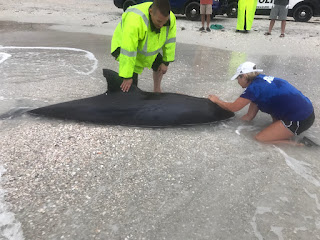Long ago, they blew up a whale carcass with dynamite to clean the beach. We strongly disapprove of this method, but it happened over 50 years ago. The good thing is that people learned from this and did not repeat such a mistake ever again. Whales often get stranded on beaches, and they should be returned to the ocean. Not just because they can explode from their own gases. When one whale gets stranded, it endangers many other whales. All whales should fear the day their relatives end up on land, wondering why. Let’s find out.
One stranded whale is already a kind of tragedy because it’s hard not to feel sad for these animals when they end their lives like this. But the problems don’t stop there. Whales have a strong social bond, so they might unknowingly follow each other to their death. If one whale gets in trouble, its distress calls can lead other whales to get stranded nearby. The group might mean well, trying to help, but the outcome is still going to be tragic.
Pilot whales
Pilot whales, which are widely known for their strong social bonds, are particularly affected by this phenomenon. Among pilot whales, it’s quite common for one whale to end up in trouble and become stranded on a beach, leading other members of the group to follow suit. This sometimes leads to a rather bizarre situation. Experts find the healthiest and least exhausted pilot whale, try to rescue it, and get it back into the water. However, it often gets stranded again because it’s attempting to reunite with its family.
But can whales actually help each other in this manner? Is it common for one whale to signal its family for help, and then the family works together to pull the stranded whale back into the water? Unfortunately, we haven’t come across any instances of whales saving each other from shallow waters. It might simply be impossible, which kind of makes sense. I mean, how’s a whale supposed to save another whale stuck on shore? The consequences might be catastrophic.
British divers and marine life rescue investigation
In June 2015, British divers and marine life rescue investigated a heartbreaking incident involving up to 20 pilot whales which ended up stranded on the shore. While some of the whales in the photos were alive and receiving help, unfortunately, not all of them made it. Eight of these whales eventually passed away, even though they were returned to the ocean.
Later findings revealed that this entire mishap was caused by the difficulties faced by a female whale during birth. She unintentionally found herself stranded in shallow waters, and her entire big family followed her. Although the fate of the female is unclear, it’s confirmed that the calf did not survive.
There are quite a few stories like this, and the most recent one happened in Australia just a month ago when around 100 whales got stranded on the beach. Now, what’s intriguing is that if you manage to get a stranded whale back into the sea within the first few minutes, it won’t have enough time to call its family for help. This can prevent further harm to other whales, and it seems like a wonderful way to rescue these creatures. However, it’s hard to imagine a scenario where a stranded whale can be quickly returned to the sea. This is mainly because it’s not possible to keep an eye on all the beaches worldwide at the same time and have a dedicated team ready to go. Yet, this remains the only effective way to prevent more whale strandings.
So, it seems like there’s no win-win solution here. There is an alternative, though you may not like it – it involves euthanizing a stranded whale. While this might seem harsh, if it means saving numerous other whales, could it be considered a humane choice? Just to be clear, we’re not advocating for the immediate killing of stranded whales. We’re simply pointing out that there’s currently no perfect and humane solution to this issue. If there is one, you can share it in the comments.
The next reasonable thing to do is to try and prevent the strandings before they happen. People have been worried about this problem for a while, so they’ve already tried several methods. In 1995, in Golden Bay, they introduced a new technique called a bubble net or air curtain. For the first time, this method used air compressors and a hose with holes that went about six to ten feet below the water surface. The curtain of bubbles acted like a barrier and bounced back the signals of the whales.
At first, the wall effectively redirected whales from the shore, but once the whales saw through the trick, it became less useful. People made a logical conclusion that this wasn’t a lasting solution, but it could help prevent released whales from getting stranded again. Since the whales are disoriented, there’s a good chance they might fall into the same trap again simply because they don’t know where they should go in the first place.
Today, boats are used to prevent whale strandings, but an air curtain could be up to the challenge as well.
The second approach
The second approach involved using the same method that draws a lot of whales closer to the shore—their own distress signal. Experts chose to record these distressed signals of whales and use them to steer the animals away from risky areas. They also considered placing a human-made device between a sick whale and its group to stop healthy whales from getting stranded on the beach. While it seemed like a good plan, things didn’t go smoothly because it’s hard to predict when and where whales will end up stranded. Moreover, it’s tough to react promptly to a situation that’s already happened.
Another option is to play a tape recording of the orca’s feeding. It could keep the pilot whales and many other whales away from places where they might get stranded. The suggestion from the expert is to place speakers and underwater equipment opposite the bay’s entrance. These devices would run on solar panel energy and pick up the sounds made by approaching whales, activating a recording. Whether this strategy is a good one or not remains uncertain, as scientists are divided on the matter. Although similar noise-based methods haven’t worked well in various parts of the world, that doesn’t rule out the possibility of success in this case. Nevertheless, we simply have to come up with something, especially since locations where whales end up stranded have unique landscapes. These places are only found in a few parts of the world, so most of the time, whales get stranded accidentally, not as part of natural events. We, as an intelligent species, should be able to learn how to predict and prevent this, don’t you think?
The interesting thing about it is that it’s cheaper to save a whale than it is to dispose of it. Some of our viewers might think it’s easy to pull all the beached animals back into the water, whether it’s five or even a hundred of them. However, the reality is that this process is incredibly challenging. Success depends on having the right circumstances and a good amount of love. So why is it so hard? Well, first, you have to know that the whales have become stranded. After that, you need to reach the location with experts in wildlife rescue. But here’s the thing – whales and their relatives are usually too large and heavy for humans to move through sheer strength. Boats and sometimes tractors are required to get the whales back out to deeper waters.
Moreover, not every coastline is suitable for carrying out this kind of operation. Rescuers often start by searching for whales who seem like good candidates to be saved from shallow waters. They usually choose those who are still alive and not completely worn out. This is because spending a lot of time and effort on an animal that’s barely hanging on might end up being pointless. It’s sad, absolutely, but that’s just the way things are.
Another challenge
There’s another challenge – dolphins and whales aren’t just big; they’re also really slippery. Now, imagine even a small whale, a pilot whale, can weigh up to 2.3 tons and be as slippery as a bar of soap. Many whales have never seen humans before, so they don’t realize they’re there to help and actively resist. Look at how many people it takes to move one single small whale. Very often, all people can do is humanely sedate them to put them out of their misery.
Coming across a beached whale is something that can happen to anyone, yet it leads to a puzzling situation. Taking matters into your own hands is risky. The whale might be injured or unwell, and returning it to the water won’t be helpful, even if you manage it alone, due to potential harm. Only a trained expert can assess the whale’s health. They’re the ones who decide whether releasing it is best or if it needs care at a rehab center, or they might suggest different ways to ease its suffering.
On the other hand, as we found out today, time is crucial in these situations. If you come across a stranded whale, you can call a special service, but they might take a while to arrive. Unfortunately, there’s no perfect solution to this problem. It’s hard to determine exactly what will ensure the whale’s survival. So, if you end up in such a situation, it’s best to contact the experts while they’re on their way. Remember not to get too close to the animal and encourage others to stay back as well. Oh, and by the way, avoid trying to pour water on the whale. It might not seem obvious, but this could accidentally block its blowhole, and the whale could suffocate before help arrives.
Whales need air to breathe
Just to remind everyone, or in this case, if it slipped your mind, whales, just like other mammals, actually need air to breathe. This means that if they end up stranded and water enters their blowhole, they can indeed drown. But don’t worry; this doesn’t happen a lot. So, a whale would have to be extremely unlucky for that to happen, like when it gets stranded on a shore when the tide comes in, and the water level rises to a point when it covers a blowhole, but the whale still can’t move or turn around to breathe. Although, of course, whales’ ability to hold their breath is phenomenal. On average, whales can hold their breath for about 60 minutes. The sperm whale takes it up a notch, managing around 90 minutes. But the reigning champion in this category is the curved beak whale, which can stay submerged for a whopping 138 minutes.
However, if these whales aren’t helped during this time, they’ll still end up dying. This video clearly shows volunteers trying to support the whale so that the animals can continue to breathe. Things are even harder for dolphins. They can’t hold their breath for an extended time, and they’ll die within 8 to 12 minutes. That’s why volunteers pour water on them, extremely carefully.
Yes, whales need to stay wet, but you know what else they need to stay alive?
The whale’s blowhole is both an intriguing and sad thing. In cartoons, we often see whales letting out small bursts of water from their blowholes – you’ve probably seen a scene like that. However, in real life, whales don’t expel water from their blowholes like that. This misunderstanding can be risky. People, driven by good intentions, sometimes try to help stranded whales by pouring water directly into their blowholes. Regrettably, this well-meant action ends up causing harm to the creatures unintentionally. Tragically, such incidents have occurred more than once. Whales actually exhale air from their blowhole, not water. The warm air from the whale’s lungs meets the cold outside air, and it turns into a cloud, similar to the vapor you see when you breathe on a cold day. This cloud contains a bit of slime and droplets of seawater, but it’s mostly made up of air.
Whales face less obvious issues on land.
Aside from humans who are too eager to help, the thing is, whales are among the largest creatures on Earth. Their bodies weigh dozens to hundreds of tons. However, all that massive muscle, bones, and organs aren’t designed for staying on land. Just a few minutes out of the water, and in their own way, it exerts immense pressure, crushing their internal organs. The more time a whale spends on land, particularly if it’s a larger species, the more extensive the damage becomes. This isn’t anyone’s fault; it’s simply the laws of physics. But can we truly hold that against them? At the end of the day, the whale might be put back into the water quite quickly, but it might not survive due to internal injuries. Think about that feeling when you step out of a pool – your body feels strangely heavy as it’s no longer buoyant in the water. That’s pretty much what whales go through, only way worse.
Plus, there’s the issue of whale blubber.
There’s a whole lot of it in the deep ocean. A thick layer of fat acts as insulation, keeping whales warm. However, when they’re on land, this fat layer functions like a fur coat, causing them to overheat. Whales produce a lot of heat to survive in the water, and this heat gets trapped by the fat. Unlike in icy waters, there’s no way for the excess heat to escape. This overheating happens quite rapidly and is exacerbated by the sun, which can even lead to skin damage similar to third-degree burns. To make matters even worse, when whales get stranded on land lying on their backs, it makes them vulnerable to scavengers like seagulls, which don’t even need to wait for the whale to die to start feeding because it’s completely helpless.
The humane way, If you saw an animal slowly suffocating to death and there was no hope of saving it, what would you do?
That’s the hard question for researchers, vets, and trained volunteers who try to save stranded whales. Those whales that manage to survive but cannot return to the ocean are in for a painful death. Their suffering can last from a few days to even a week. In such situations, euthanasia appears to be the most logical solution. However, the complexity lies in the fact that a whale, being a massive creature weighing several tons, can’t be euthanized with a simple injection.
Some people use explosives to swiftly kill the animal, while others prefer exsanguination, but the specifics aren’t very pleasant, so we won’t go into detail here. Then there’s the whole issue with the medicines they use – some are not allowed, and some could harm other animals in the environment. Luckily, quite recently, scientists discovered a combination of medications that can gently influence whales without violating any rules or causing harm to other animals. It’s kind of bittersweet news.
The main issue
The main issue with whale strandings is that experts often struggle to figure out why they happen in the first place, even when they carefully study and collect samples. It’s tough because there are so many possible reasons. Each time, a new factor that’s been added to the list recently is solar storms. Even though the Sun is far away, it affects us, so why wouldn’t it affect whales? The idea is that solar storms involve intense bursts of energy from the Sun, including radiation and electromagnetic energy. When these storms hit the Earth’s upper atmosphere, they can mess with the magnetic field. These disturbances are strong enough to disable satellites, interfere with power grids, and impact GPS systems. Now, marine animals like whales partly rely on magnetic fields to navigate in the sea. So, if we connect the dots, it seems pretty reasonable that solar storms could affect whales as well. After all, if a solar storm can mess up GPS, it could also mess up an animal’s internal compass. That’s sort of a relief, finally, it’s not humans’ fault that animals are facing problems. Not much to celebrate, though.



